You also want an ePaper? Increase the reach of your titles
YUMPU automatically turns print PDFs into web optimized ePapers that Google loves.
and withdrawal of Soviet armies into the Soviet Union, the disintegrationof the Warsaw Pact, and the dismemberment and disappearance of theSoviet Union seemed to many to remove the justification for maintaininga powerful U.S. Army. Political leaders sought a “peace dividend,” andthe Army projected budgets that would decrease the number of its activeservice members from seven hundred eighty thousand in 1989 to fivehundred thirty-five thousand in 1995. Some Americans believed long-termpeace was the order of the day and that we could dismantle our “bloated”military establishment. That “bloated” establishment would soon show theworld how effective, and needed, it was. The United States would sendthe best-prepared force America had ever deployed in response to nakedaggression in the Persian Gulf.As Saddam Hussein’s attack unfolded, three armored divisions ofthe elite Iraqi Republican Guard crossed the Kuwaiti border and spedtoward the capital city. The several brigades and potpourri of militaryequipment of the hapless Kuwaiti Army, already disorganized by attacksfrom Iraqi special operations forces, proved no match for this assault.Within days, the Kuwaitis had surrendered or fled to Saudi Arabia, theRepublican Guard divisions had closed to the Saudi border, and Iraqifollow-on forces had fanned out to secure the oil fields and commercialwealth of the small but prosperous country. Iraq had long coveted oilrichKuwait, characterizing it as a nineteenth province the British hadpurloined during the colonial era. Iraq’s ambition had become aggravatedduring the prolonged, desultory Iran-Iraq War (1980–1988). Husseinhad accrued enormous debts fighting the Iranians, leaving him with alarge and battle-hardened army but an economy in disarray. The wealthof Kuwait, in his mind, could fix this problem.Hussein’s army had grown tenfold during the war with Iran. Whenfully mobilized, it numbered over a million soldiers. Perhaps moreimportant, it was well equipped by the virtue of huge purchases frominternational arms markets. Although most of this equipment was ofSoviet design and a generation behind its American counterparts, thesheer numbers of tanks, armored fighting vehicles, artillery pieces, andsmall arms of all types made it formidable. Although the Soviet Unionwas no longer available to assist Iraq internationally, Hussein couldcount on support among the most polarized or disaffected elements ofthe Arab World. Iraq’s standing as a “Sunni Shield” against the powerof resurgent Shi’ite Iran made many Arab states loath to confront himdirectly. For many in the region, Kuwait was seen as little more thanan American dependency, and defiance of Israel’s ally America wasrighteous in many Arabs’ eyes.2












